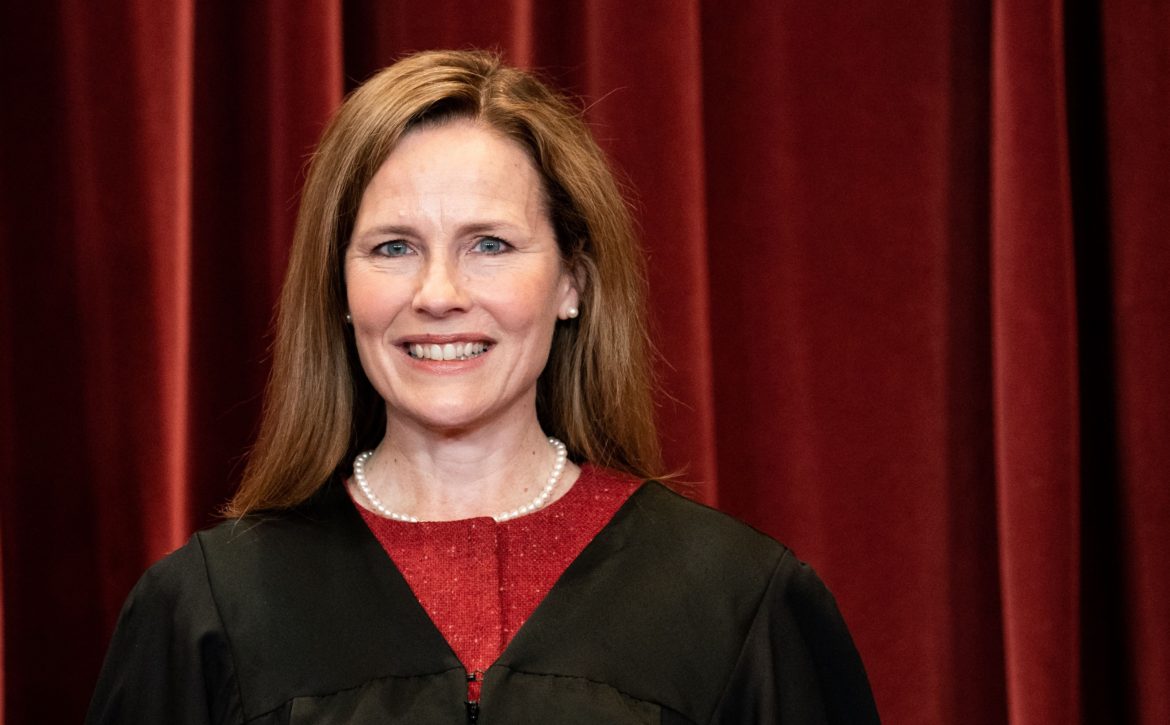
It Sure Looks Like Roe’s Foes Noticed That Amy Coney Barrett Is on the Supreme Court
When the state of Mississippi first asked the Supreme Court to take up Dobbs v. Jackson Women’s Health Organization in March 2020, it argued that the court didn’t need to overturn Roe v. Wade to rule in favor of the state’s 15-week ban on abortions. The Supreme Court duly agreed in May to hear the case and decide “whether all pre-viability prohibitions on elective abortions are unconstitutional.” The dispute is now set to be the first major abortion-related case heard by the court, whose conservative majority has been newly bolstered by its sixth member, Amy Coney Barrett.Barrett is the likely reason that Mississippi has suddenly starting singing a very different tune. Last week, the state suddenly switched up its plan of attack, arguing in its brief for the court that “nothing in constitutional text, structure, history, or tradition supports a right to abortion” and that the only real barriers to the state’s ban are Roe and Planned Parenthood v. Casey, a 1992 case that reaffirmed and rewrote Roe’s central holding. “Roe and Casey are thus at odds with the straightforward, constitutionally grounded answer to the question presented,” Mississippi declared in its brief for the court. “So the question becomes whether this Court should overrule those decisions. It should.”The state’s tactical about-face underscores the threat posed by Dobbs to Roe, Casey, and nearly a half-century of legalized abortion. Thirty-eight of the 49 pages in Mississippi’s brief are devoted to the case for overturning Roe and Casey. In theory, this should be a formidable task. The Supreme Court, following the example set by English courts before the revolution, decides cases by applying precedents from past cases to new sets of facts. Under the principle of stare decisis, the court is supposed to be extremely reluctant to overturn those precedents, even if later generations of justices think the reasoning behind them is dubious or erroneous.That’s the A.P. Government explanation, at least. In reality, the high court’s approach to precedent is far more mercurial. At times, the justices hew closely to past decisions despite their clear misgivings about them, as some of the court’s conservatives did earlier this year when they declined to overturn a 1990 case that limits some types of religious freedom claims. In other instances, the justices jettison stare decisis altogether, as the court’s conservatives did earlier this year when they overturned a major criminal rights precedent—even though nobody had asked them to do it.Mississippi lays out a litany of reasons why it believes Roe and Casey meet the high threshold to overturn precedent. Some are familiar features in the abortion debate. The state argued, as many anti-abortion groups and activists have done since 1973, that there is no constitutional right to abortion and that Roe is flat-out wrong. It contended that Casey’s undue-burden test for abortion-related restrictions doesn’t provide lower courts with an objective test for weighing state laws that affect the procedure. The state cited increased contraceptive use and wider access to adoption services as proof that Roe’s thinking on unwanted pregnancies was out of date.Other arguments are slightly more circular. Mississippi complained, for instance, that the court’s refusal to overturn Roe in Casey only harmed the court’s legitimacy even further (at least in the eyes of anti-abortion groups and proponents) and that Roe’s limits on the states’ power to restrict abortion have “placed this court at the center of a controversy that it can never resolve.” Well, yes. Much of this political discord and perceived judicial illegitimacy flows from anti-abortion groups’ opposition to Roe and their ceaseless efforts to overturn the landmark 1973 ruling. The court can’t “resolve” the matter, in large part, because states like Mississippi keep passing laws that defy the court’s past decisions on the matter. The court must overturn Roe, Mississippi argued, because the states keep trying to ignore Roe.This reasoning reached its most cynical heights on the question of reliance interests—that is, how much is vested by Americans in the status quo. “Repudiating the rule of Roe and Casey would not itself bar a single abortion,” Mississippi boldly claimed. “It would simply let the people resolve the issue themselves through the democratic process. Indeed, many states have already accounted for Roe and Casey’s overruling: some by statutorily codifying the right endorsed in those cases or otherwise providing broad access to abortion; others by adopting restrictions that cannot stand under Roe and Casey but would take effect if they were overruled.” In other words, the state argued that because some states feared or hoped that the anti-Roe campaign might succeed, it should succeed.This is a far cry from how Mississippi initially framed the stakes of this case last year. “To be clear, the questions presented in this petition do not require the court to overturn Roe or Casey,” the state wrote in its petition in March 2020. “They merely ask the court to reconcile a conflict in its own precedents.” Mississippi added that the court “should not retain erroneous precedent” if it “cannot reconcile Roe and Casey with other precedents or scientific advancements showing a compelling state interest in fetal life far earlier in pregnancy than those cases contemplate.” But the state included that point in a mere footnote instead of making it the center of its argument.So what changed? From a purely legal perspective, nothing. The only abortion rights ruling between the petition’s filing and the brief’s filing was June Medical Center v. Russo, where the court struck down a Louisiana law that aimed to shut down most of the state’s abortion clinics for violating Casey’s undue-burden standard. Chief Justice John Roberts grudgingly joined with the court’s four liberals at the time, out of deference to stare decisis. The court, he noted, had reached an identical conclusion about a nearly identical Texas law in Whole Woman’s Health v. Hellerstedt four years earlier.But Roberts is no longer the fulcrum of the court, and that means everything. Ruth Bader Ginsburg’s death last September left the court with only three clear votes to uphold Roe and Casey. President Donald Trump nominated Justice Amy Coney Barrett to fill the vacancy, and Senate Republicans raced to confirm her last October, before the election. Barrett’s views on abortion are about as mysterious as the average Scooby Doo episode: She signed a newspaper ad that called Roe “barbaric” in 2006 and belonged to an anti-abortion organization in Indiana as recently as 2016. If conservatives didn’t think she’d rule accordingly from the bench, they wouldn’t have elevated her to the nation’s highest court.As Vox’s Ian Millhiser noted last week, Mississippi’s brief is a sharp rhetorical turn from the litigation strategies used by anti-abortion groups and governments over the past three decades. Anthony Kennedy, the court’s longtime swing vote, largely favored abortion-related restrictions when they came before the court. But he was also part of the Casey troika that saved Roe in 1992 and refused to let states outlaw the procedure altogether. “So abortion opponents spent the years when Kennedy held the balance of power on the Court drafting more and more aggressive abortion restrictions that purported to be something other than an outright ban,” Millhiser explained.Ironically, Mississippi’s direct move against Roe was slightly out of step with the broader anti-abortion movement in Dobbs. The National Right to Life Committee, a leading anti-abortion organization, filed its own friend-of-the-court brief one day after the state. Playing by the old rules, the group merely asked the justices for “a new roadmap” to guide the way back from “Roe’s tangential departure from normal legal norms.” As Mississippi once did, the NRLC said in a footnote that the court “need not reach the end of the road” in Dobbs and that “the decision on whether to reach the end of the road will likely rest with future [Supreme] Courts.” If Mississippi has its way, however, the future is now.
Read More


